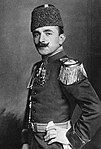İsmail Enver, better known as Enver Pasha (Ottoman Turkish: اسماعیل انور پاشا; Turkish: İsmail Enver Paşa; 22 November 1881 – 4 August 1922) was an Ottoman military officer, revolutionary, and convicted war criminal who formed one-third of the dictatorial triumvirate known as the "Three Pashas" (along with Talaat Pasha and Cemal Pasha) in the Ottoman Empire.
Enver was a member of the Committee of Union and Progress (CUP), a Young Turk organization that agitated against Abdul Hamid II's absolute rule. He was a leader of the 1908 Young Turk Revolution which reestablished the Constitution and parliamentary democracy in the Ottoman Empire, and along with Ahmed Niyazi was hailed as "hero of the revolution". However multiple crises in the Empire including the 31 March Incident, the Balkan Wars, and the power struggle with the Freedom and Accord Party made Enver and the Unionists disillusioned of political pluralism. After the 1913 Ottoman coup d’état that brought the CUP directly to power, Enver Pasha took control of the Ottoman army, becoming (4 January 1914) the Minister of War, while Talaat took control over the civilian government.
As war minister and de facto Commander-in-Chief (despite his role as the de jure Deputy Commander-in-Chief, as the Sultan formally held the title), Enver Pasha was one of the most powerful figures of the government of the Ottoman Empire. Enver Pasha led a disastrous attack on Russian forces in the Battle of Sarikamish, after which he blamed Armenians for his defeat. Along with Talaat, he was one of the principal perpetrators of the Late Ottoman Genocides and thus is held responsible for the death of between 800,000 and 1,800,000 Armenians, 300,000 Assyrians and 750,000 Greeks. Following defeat in World War I, Enver, along with other leading Unionists, escaped the Ottoman Empire. The Ottoman Military Tribunal convicted Enver Pasha and other Unionists to death in absentia for bringing the Empire into World War I and organizing massacres against Greeks and Armenians. Enver ended up in Central Asia, where he was killed leading the Basmachi Revolt against the Bolsheviks.
In the course of his career he was known by increasingly elevated titles as he rose through military ranks, including Enver Efendi (انور افندی), Enver Bey (انور بك), and finally Enver Pasha, "pasha" being the honorary title Ottoman military officers gained on promotion to the rank of Mirliva (major general).










